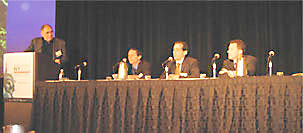Surgeons create wish list of short-term developments in computer-assisted surgery
At top of the list: pinless systems, simplification, improvement in soft-tissue, ligament balancing.
 When it comes to technology, bigger (or smaller) and better versions always seem to be waiting just around the corner. Computer-assisted orthopedic surgery is no different.
When it comes to technology, bigger (or smaller) and better versions always seem to be waiting just around the corner. Computer-assisted orthopedic surgery is no different.
As a fairly new technology, developments in computer navigation are still on the horizon. Surgeons with experience in the technology predict that companies will introduce pinless navigation capabilities and systems that allow soft-tissue and ligament balancing within the next few years.
But surgeons should not avoid implementing computer navigation systems while waiting for the new technology, said William J. Hozack, MD, of Philadelphia.
“There’s no reason that you shouldn’t consider starting to use [navigation] and become familiar with the current technology because when you use navigation you can adapt very easily to the new technology that comes along,” Hozack said at Orthopedics Today New York 2006 A Comprehensive CME Course.
Whether surgeons find value in early adoption or in waiting it out for better technology, Hozack and others agree that long-awaited and necessary developments are on the way for computer navigation.
Accuracy developments
One future navigation development will be the ability to map surfaces using methods that do not require touching or digitizing the surface, such as ultrasound or arthroscope, according to Peter M. Bonutti, MD, FACS, of Effingham, Ill. Most current navigation systems allow surgeons to digitally map surfaces during surgery, but this can lead to inaccuracies.
“If we could … have some reproducible way of mapping the surface, I think that would change and certainly speed up the surgery and decrease the complexity some,” Bonutti said. “I see that happening really soon.”
Further, the pins in the tibia and pelvis used by current systems can sometimes interfere with the surgery, said David J. Mayman, MD, of New York. “I think we’re going to get better trackers and hopefully true pinless systems,” as opposed to the smaller or less pins used today, he said.
Current navigation systems also mathematically calculate ligament balancing and ligament tensioning, rather than provide direct measurements.
Image: Stiglich JM |
“For the future, we’re going to need instrumentation that directly measures the tensions on the trials for all the evident surfaces and we can balance them with the image,” Bonutti said.
Hozack said surgeons might also start using the navigation systems for more specific parts of the surgery, such as soft-tissue balancing in the hip and knee, “so that it actually is a better-feeling operation at the end of the day,” he said.
Simplicity is key
Surgeons and industry are also realizing that the navigation systems can be too complex, providing too much information at once, this also may change soon.
“There are ways that you can actually eliminate most of the information that’s on the screen and just look at distal femoral cut, tibial cut and alignment,” Hozack said.
Bonutti said: “It is almost information overload.” But, he added, the next evolution of these computers will allow a surgeon to distill the less relevant information from what’s important. “I think all of the companies are coming out with that very shortly,” he said.
The surgeons also agreed that computer navigation is headed toward an image-free system, as opposed to CT-based or image-based systems.
Teaching with navigation
In the future computer navigation may also serve as a teaching tool for fellows and residents. While surgeons should not solely depend on computer navigation to perform surgery, they can use the technology to check their work, Mayman said – for example, how close are they to an anatomic placement of the acetabulum before reaming.
A learning tool
Hozack said he now encourages residents and fellows to use navigation when learning how to make incisions – after using standard instrumentation first.
Surgeons might also use navigation systems to record data that does not currently exist in the literature, such as normal range of motion for the hip or normal ligament tensioning in the knee.
Mayman said he and his colleagues are working with a company to develop a ligament tensioner that allows a surgeon to equate valgus to different pressures and measure gaps on the medial and lateral sides.
“Now that we can collect that data, hopefully it will bring some value to the operating room,” Mayman said.
For more information:
- Bonutti PM, D’Ambrosia RD, Hozack WJ, Mayman DJ. Future trends for computerized total hip replacement and total knee replacement. Presented at Orthopedics Today NY 2006 – A Comprehensive CME Course. Nov. 11-12, 2006. New York.
- Peter M. Bonutti, MD, FACS, is an orthopedic surgeon at the Bonutti Clinic, 1303 West Evergreen Avenue, Effingham, IL 62401. He can be contacted at 217 342-3400, or pbonutti@bonutti.net.
- William J. Hozack, MD, is an orthopedic surgeon at the Rothman Institute, 925 Chestnut Street, 5th Floor, Philadelphia, PA 19107-4216. He can be contacted at 215 955-5459, or at william.hozack@mail.tju.edu.
- David J. Mayman, MD, is an orthopedic surgeon at the Hospital for Special Surgery, East River Professional Building, 3rd Floor, 523 East 72nd Street, New York, NY 10021. He can be contacted at 212 774-2024, for maymand@hss.edu.
- Drs. Bonutti and Hozack are consultants for Stryker Orthopedics.

